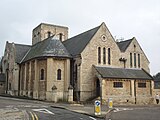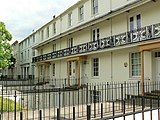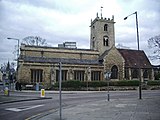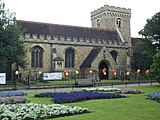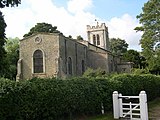Victor Farrar | |
|---|---|
 | |
| Born | 1930 |
| Died | 23 August 2007 |
| Nationality | British |
| Occupation | Architect |
Victor John Frederick Farrar RIBA PPFAS FRSA (1930 – 23 August 2007), also known as V.J.F. Farrar, was an architect known for his restoration work at a time when respect for architectural heritage was at a low ebb. [1] [2] [3] [4] His obituary in The Guardian stated that ‘he put a training in classical design techniques to good use in his speciality of building restoration’. [1] Farrar’s obituary in his old school magazine reflected that, at the time, ‘it was rare to find a professional willing to take a public stand against the post war establishment, which in Bedford, as in many towns, saw little merit in the preservation of what we now call heritage’. [2]
Farrar was a President of the Faculty of Architects and Surveyors and a member of the Architects’ Benevolent Society. [2] [5] He was elected to the Great Barford parish council in 1959 which he served for 21 years and was, towards the end of his tenure, its Chairman. [2] He was Honorary Treasurer of the Bedfordshire Parish and Town Council Committee, Chairman of the Bedford Society, a member of the Great Ouse Restoration Society and an organiser of the Bedford River Festival. [2]
Life
Victor John Frederick Farrar was born in Bedford, England in 1930. [2] He was educated at Bedford Modern School between 1940 and 1946 where he excelled at cross country running for which he would later represent Bedfordshire. [2] Farrar’s success at the sport was such that he became an Honorary Life Member of the English Cross Country Union. [2]
Farrar joined the Royal Engineers for National Service after which he took up a course in architecture at the Rochester Technical College and subsequently worked with Bedfordshire County Council. [2] In 1950, Farrar joined the architectural practice of Sir Albert Richardson where the experience gave him great insight into classical design and proved the foundation of his subsequent work in restoration. [2] Like Richardson, he was adept at fast sketches which he would later use for Christmas cards. [2]
In 1962, Farrar set up the Victor Farrar partnership and was proactive in the dioceses of Peterborough and St Albans for church restoration. [2] [6] [7] [8] He subsequently wrote a report for the Bedford Society regarding the plight of four Bedford churches that had become redundant: St Mary’s, St Cuthbert’s, Holy Trinity and St Leonard. [2] St Cuthbert’s was rescued by the Harpur Trust and subsequently given to the Polish community in Bedford. [9] The church of St Leonard was the only one of the four to be demolished. [2]
In 1978, Farrar was appointed to restore the nave and chancel of St Paul's Church, Bedford. [2] He also restored the west gallery at the church, [2] and its spire. [10] St Paul's has been described as being of cathedral proportions. [11]
Farrar was elected to the Great Barford parish council in 1959 which he served for 21 years and was, towards the end of his tenure, its Chairman. [2] He was Honorary Treasurer of the Bedfordshire Parish and Town Council Committee, a President of the Faculty of Architects and Surveyors, a member of the Architects’ Benevolent Society, Chairman of the Bedford Society, a member of the Great Ouse Restoration Society and an organiser of the Bedford River Festival. [2]
As consultant architect for the Bedford Society and at his own expense, Farrar funded a restoration package for the Priory Terrace in Bedford, 20-48 Bromham Road, a regency style building that was scheduled for demolition in 1970. [2] He was able to secure a developer, Kingsbury Securities, to turn the property into offices and flats and the building is now one of Bedford’s landmarks for which Farrar was awarded the Sheffield Rose Bowl. [2] [12]
Farrar died on 23 August 2007 at Wilden, Bedfordshire, England. [2] His obituary in The Guardian stated that ‘he put a training in classical design techniques to good use in his speciality of building restoration’. [1] Farrar’s obituary in his old school magazine reflected that at the time ‘it was rare to find a professional willing to take a public stand against the post war establishment, which in Bedford, as in many towns, saw little merit in the preservation of what we now call heritage’. [2]
Farrar was survived by his wife, Denise, and his children, Roxana and Nicholas. [2]
Publication
- Bedford 50 years ago. The architecture of a County Town, by Victor J F Farrar. Published 2007
Gallery
-
St Cuthbert’s in Bedford, which Farrar helped save from demolition
-
St Paul’s Church, Bedford, where Farrar restored the nave and chancel
-
Priory Terrace, Bedford, which Farrar saved from demolition
-
St Mary's Church, Bedford, which Farrar saved from demolition
-
St Peter's Church, Bedford, where Farrar carried out inspection reports
-
Church of St Mary Magdalene, Melchbourne, where Farrar carried out restoration work
References
- ^ a b c Wildman, Richard (November 29, 2006). "Obituary: Victor Farrar" – via www.theguardian.com.
- ^ a b c d e f g h i j k l m n o p q r s t u v w "Bedfordshire Archives Service Catalogue | Details". bedsarchivescat.bedford.gov.uk.
- ^ "The Estates Gazette". April 30, 1979 – via Google Books.
- ^ "The Archaeological Journal". Longman, Rrown,(sic) Green, and Longman. March 30, 1996 – via Google Books.
- ^ "The Estates Gazette". October 30, 1978 – via Google Books.
- ^ "Quinquennial inspection report on the church by V.J.F.Farrar, architect, Bedford, with supplementary report, and covering letter". May 30, 1970 – via National Archive of the UK.
- ^ "Simons Family Mamorial Window". www.all-saints-church-renhold.org.
- ^ "RIBA International Directory of Practices". Royal Institute of British Architects. March 30, 1995 – via Google Books.
- ^ "St. Cuthbert's Church, Bedford, Bedfordshire". www.r-l-p.co.uk.
- ^ Bedfordshire on Sunday, November 4, 1984, p. 5
- ^ "St Paul's Church, Bedford". St Paul's Church, Bedford.
- ^ The Eagle, The Magazine of Bedford Modern School, Volume 40 (6), 1978-79, Number 289, p.220
Victor Farrar | |
|---|---|
 | |
| Born | 1930 |
| Died | 23 August 2007 |
| Nationality | British |
| Occupation | Architect |
Victor John Frederick Farrar RIBA PPFAS FRSA (1930 – 23 August 2007), also known as V.J.F. Farrar, was an architect known for his restoration work at a time when respect for architectural heritage was at a low ebb. [1] [2] [3] [4] His obituary in The Guardian stated that ‘he put a training in classical design techniques to good use in his speciality of building restoration’. [1] Farrar’s obituary in his old school magazine reflected that, at the time, ‘it was rare to find a professional willing to take a public stand against the post war establishment, which in Bedford, as in many towns, saw little merit in the preservation of what we now call heritage’. [2]
Farrar was a President of the Faculty of Architects and Surveyors and a member of the Architects’ Benevolent Society. [2] [5] He was elected to the Great Barford parish council in 1959 which he served for 21 years and was, towards the end of his tenure, its Chairman. [2] He was Honorary Treasurer of the Bedfordshire Parish and Town Council Committee, Chairman of the Bedford Society, a member of the Great Ouse Restoration Society and an organiser of the Bedford River Festival. [2]
Life
Victor John Frederick Farrar was born in Bedford, England in 1930. [2] He was educated at Bedford Modern School between 1940 and 1946 where he excelled at cross country running for which he would later represent Bedfordshire. [2] Farrar’s success at the sport was such that he became an Honorary Life Member of the English Cross Country Union. [2]
Farrar joined the Royal Engineers for National Service after which he took up a course in architecture at the Rochester Technical College and subsequently worked with Bedfordshire County Council. [2] In 1950, Farrar joined the architectural practice of Sir Albert Richardson where the experience gave him great insight into classical design and proved the foundation of his subsequent work in restoration. [2] Like Richardson, he was adept at fast sketches which he would later use for Christmas cards. [2]
In 1962, Farrar set up the Victor Farrar partnership and was proactive in the dioceses of Peterborough and St Albans for church restoration. [2] [6] [7] [8] He subsequently wrote a report for the Bedford Society regarding the plight of four Bedford churches that had become redundant: St Mary’s, St Cuthbert’s, Holy Trinity and St Leonard. [2] St Cuthbert’s was rescued by the Harpur Trust and subsequently given to the Polish community in Bedford. [9] The church of St Leonard was the only one of the four to be demolished. [2]
In 1978, Farrar was appointed to restore the nave and chancel of St Paul's Church, Bedford. [2] He also restored the west gallery at the church, [2] and its spire. [10] St Paul's has been described as being of cathedral proportions. [11]
Farrar was elected to the Great Barford parish council in 1959 which he served for 21 years and was, towards the end of his tenure, its Chairman. [2] He was Honorary Treasurer of the Bedfordshire Parish and Town Council Committee, a President of the Faculty of Architects and Surveyors, a member of the Architects’ Benevolent Society, Chairman of the Bedford Society, a member of the Great Ouse Restoration Society and an organiser of the Bedford River Festival. [2]
As consultant architect for the Bedford Society and at his own expense, Farrar funded a restoration package for the Priory Terrace in Bedford, 20-48 Bromham Road, a regency style building that was scheduled for demolition in 1970. [2] He was able to secure a developer, Kingsbury Securities, to turn the property into offices and flats and the building is now one of Bedford’s landmarks for which Farrar was awarded the Sheffield Rose Bowl. [2] [12]
Farrar died on 23 August 2007 at Wilden, Bedfordshire, England. [2] His obituary in The Guardian stated that ‘he put a training in classical design techniques to good use in his speciality of building restoration’. [1] Farrar’s obituary in his old school magazine reflected that at the time ‘it was rare to find a professional willing to take a public stand against the post war establishment, which in Bedford, as in many towns, saw little merit in the preservation of what we now call heritage’. [2]
Farrar was survived by his wife, Denise, and his children, Roxana and Nicholas. [2]
Publication
- Bedford 50 years ago. The architecture of a County Town, by Victor J F Farrar. Published 2007
Gallery
-
St Cuthbert’s in Bedford, which Farrar helped save from demolition
-
St Paul’s Church, Bedford, where Farrar restored the nave and chancel
-
Priory Terrace, Bedford, which Farrar saved from demolition
-
St Mary's Church, Bedford, which Farrar saved from demolition
-
St Peter's Church, Bedford, where Farrar carried out inspection reports
-
Church of St Mary Magdalene, Melchbourne, where Farrar carried out restoration work
References
- ^ a b c Wildman, Richard (November 29, 2006). "Obituary: Victor Farrar" – via www.theguardian.com.
- ^ a b c d e f g h i j k l m n o p q r s t u v w "Bedfordshire Archives Service Catalogue | Details". bedsarchivescat.bedford.gov.uk.
- ^ "The Estates Gazette". April 30, 1979 – via Google Books.
- ^ "The Archaeological Journal". Longman, Rrown,(sic) Green, and Longman. March 30, 1996 – via Google Books.
- ^ "The Estates Gazette". October 30, 1978 – via Google Books.
- ^ "Quinquennial inspection report on the church by V.J.F.Farrar, architect, Bedford, with supplementary report, and covering letter". May 30, 1970 – via National Archive of the UK.
- ^ "Simons Family Mamorial Window". www.all-saints-church-renhold.org.
- ^ "RIBA International Directory of Practices". Royal Institute of British Architects. March 30, 1995 – via Google Books.
- ^ "St. Cuthbert's Church, Bedford, Bedfordshire". www.r-l-p.co.uk.
- ^ Bedfordshire on Sunday, November 4, 1984, p. 5
- ^ "St Paul's Church, Bedford". St Paul's Church, Bedford.
- ^ The Eagle, The Magazine of Bedford Modern School, Volume 40 (6), 1978-79, Number 289, p.220
